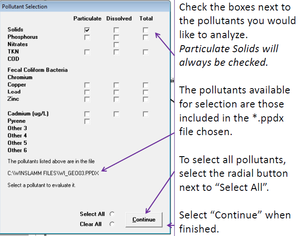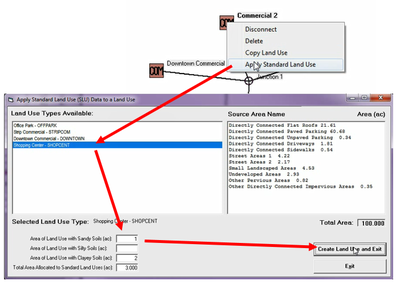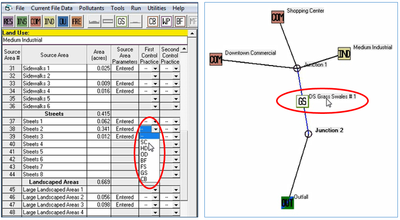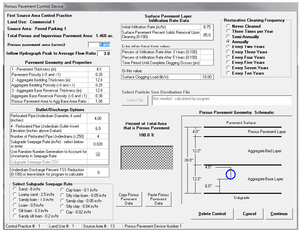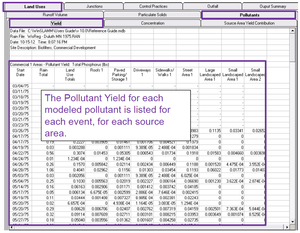
Recommendations and guidance for utilizing WINSLAMM to meet TMDL permit requirements
The Source Loading and Management Model (WinSLAMM) is a proprietary stormwater quality model originally developed for the United States Geological Survey (USGS) for the evaluation of non-point pollution in urban areas and pollutant removal at water quality best management practices (BMPs). WinSLAMM uses experimentally derived runoff coefficients to predict runoff and associated pollutant loading from a number of land use types. A unique feature in WinSLAMM is that within defined land use types (e.g., commercial, residential, etc.), the program tracks loading from many different types of source areas (e.g., roofs, parking lots, etc.) and further distinguishes source areas using source area parameters (e.g., is the roof flat or pitched? Does the roof drain to a pervious surface?, etc.). WinSLAMM provides this level of specificity so that unique runoff coefficient and pollutant loading assumptions can be applied to source areas within land use types, allowing for refinement of runoff and pollutant loading results.
WinSLAMM predicts pollutant removal at water quality BMPs based on correlation to experimental results (empirical) as well as modeling the generation and removal of particulates through sedimentation and filtration (physically-based). By modeling hydraulic performance at BMPs and physically tracking the particle size distribution (PSD) through BMPs, WinSLAMM is capable of modeling bypass from BMPs and is capable of predicting performance of BMPs in series (i.e., treatment train). WinSLAMM is a continuous model which can produce results for long term simulations and produce results for individual rainfall events. It should be noted that WinSLAMM simulations are done in batch mode, which means that it is not modeling individual rainfall events in real-time, and accounting for antecedent moisture conditions for pervious runoff, the way that P8 does.
WinSLAMM is a versatile program suitable for total maximum daily load (TMDL) applications ranging from TMDL development, to demonstrating wasteload allocation (WLA) and permit compliance from individual Municipal Separate Storm Sewer Systems (MS4s). Download links for WinSLAMM and related documentation are provided below. As noted above, WinSLAMM is a proprietary model which needs to be licensed or purchased before use.
Note: information provided in the following subsections does not reiterate or re-present information readily available in model documentation files. Instead, guidance provided in this document provides engineers and planners with recommendations for development of model inputs, provides guidance for interpreting and summarizing model results, provides supplementary information not included in model documentation, and provides examples showing how WinSLAMM can be used to demonstrate TMDL compliance.
Applicability to demonstrating WLA compliance
WinSLAMM is a continuous water quality model capable of summarizing runoff and associated total suspended solids (TSS) and total phosphorus (TP) generation, removal, and outflow loading from individual catchments, individual BMPs and junctions, or as a model wide summary. Additionally, because WinSLAMM models the particulate and pollutant particle-scale distribution through filtration and sedimentation BMPs and models hydraulic performance of BMPs based on watershed loading and BMP dimensions, the model is capable of accurately predicting pollutant removal through BMPs in series as well as predicting runoff and pollutant bypass from undersized undersized BMPs. Due to this flexibility, WinSLAMM is capable of providing accurate pollutant removal estimates regardless of BMP network and subwatershed configuration, and is capable of demonstrating compliance to mass-based Water Quality Based Effluent Limits (WQBELs), concentration-based WQBELS, and areal-loading based WQBELS (e.g., lbs of TSS per acre per year) for both TSS and TP.
Model inputs
The following subsections outline data sources and special consideration related to model inputs, model setup, and model initialization. Note: these subsections do not represent information readily available in Model documentation, but instead highlight data sources (e.g., spatial datasets), special consideration, and important notes for engineers and planners to consider while generating model inputs.
Current file data: parameter files
WinSLAMM requires a number of parameter files to generate runoff, particulate loading, and pollutant accumulation and washoff from source areas within each land use type. Each of the required parameters files is described briefly, below:
- Rain File (".RAN"): specifies rainfall event date, duration, and depth for the modeled period.
- Runoff Coefficient File (“.RSVX”): specifies the runoff coefficient (Rv) for each source area as a function of rainfall event depth.
- Particulate Solids Concentration File (“.PSCX”): specifies the particulate solids concentration (mg/L) for each source area as a function of rainfall depth.
- Source Area PSD and Peak to Average Flow Ratio File (“.CSV”): specifies the particle scale distribution (PSD) file (“.CPZ”) and the peak-to-average flow ratio for each source area.
- Particle Size Parameter Files (“.CPZ”): specifies the PSD for particulates generated from a WinSLAMM source area. Unique PSD “.CPZ” files can be applied to each source area.
- Street Delivery File (“.STD”, six (6) files): specifies the washoff coefficient for street textures as a function of rainfall depth. Note: unique street delivery files can be applied to road surface sources areas for each of the six (6) land use types.
- Pollutant Probability Distribution Files (“.PPDX”): specifies the particulate pollutant concentration associated with generated particulate (mg/kg) and the dissolved pollutant concentration (mg/L) for all modeled pollutant constituents from all source areas within each land use type.
The Rain File (“.RAN”), which specifies rainfall events, duration, and depth for the modeled period, is regionally specific and should be developed for the study area. The National Oceanic and Atmospheric Administration (NOAA) maintains a searchable database that can be used to search for hourly precipitation data based by city or geographic region (e.g., zip code). Local area airports (e.g., Minneapolis Saint Paul International Airport) are another resource that can be used to develop required precipitation data inputs. As described in model documentation, rainfall input “.RAN” files can be created within the Rainfall File Editor (“Utilities → Parameter Files → Rainfall Files”).
The remaining parameter files (Runoff Coefficient File (“.RSVX”), Particulate Solids Concentration File (“.PSCX”), Source Area PSD and Peak to Average low Ratio File (“.CSV”), Particle Size Parameter Files (“.CPZ”), Street Delivery Files (“.STD”), and Pollutant Probability Distribution Files (“.PPDX”)) contain input values that must be generated from literature values, case studies, or water quality monitoring data. For this reason, default parameter files have been generated for several geographic locations across the United States and are provided in WinSLAMM documentation. Additionally, some state and local agencies have developed state-wide or regional WinSLAMM input parameter files. For this reason, it is recommended that the engineer or designer first determine if local or regional parameter files have been developed before utilizing default regional parameter files provided in the WinSLAMM model files. Documentation shows the six WinSLAMM parameter files regions. The “Great Lakes” region provides coverage for the majority of Minnesota and should be used if local or regional parameter files are not available for the study area.
Special Consideration(s):
- The rainfall editor within WinSLAMM can be used to make Rain File(s) (“.RAN”) unique to the study area (“Utilities → Parameter Files → Rainfall Files”).
- Parameter files can be viewed and edited from “Utilities → Parameter Files”.
- Default parameter files unique to each “Parameter File Region” are included in WinSLAMM program files.
Current file data: job control
Job control parameters related to model run time are specified in the “Current File Data” window. Job control parameters are described briefly, below:
- Start Date / End Date: specifies the start and stop date of simulation.
- Start / End of Winter (mm/dd): specifies the date range that represents winter conditions. Winter conditions impact how runoff is generated as well as particle accumulation and washoff from road surfaces.
Special Consideration(s):
- The start date / end date must be within the date range in the Rain File (“.RAN”).
- Model documentation files suggest a winter start and end date of December 3 (12/03) to March 21 (03/21) for the “Great Lakes” parameter file region.
Job control: pollutant selection
Accessed through the “Pollutants” tab on the main WinSLAMM model menu, the “Pollutant Selection” window defines which pollutant(s) included in the Pollutant Probability Distribution (“.PPDX”) file will be modeled and tracked in reported model outputs.
Special Consideration(s):
- For phosphorus TMDLs, it is recommended that the “particulate”, “dissolved”, and “total” radial options be selected.
- Only pollutants included in the selected Pollutant Probability Distribution File (“.PPDX”) file will be included in the “Pollutant Selection” window.
Job control: program options
Job control parameters and options related to output generation within WinSLAMM “Program Options” (“Tools → Program Options”) should be reviewed by the engineer or designer before performing model simulation. The “Program Options” window is separated into three tabs. A brief discussion of each of the “Program Options” tab is provided below:
- Default Current File Data: specifies default parameter files applied to “Current File Data”
- Default Model Options: specifies several job control parameters and options related to model output. The designer or engineer should review the “Default Time Increment (min)”, which defines the time increment used to route flow and pollutant hydrographs between control practices. Additionally, if outflow hydrographs or particle size distribution files are required, the “Create Hydrograph and Particle Size Distribution .csv Files” radial button should be selected.
- Default Output File Options: specifies optional result outputs for each of eleven (11) control practices. Reporting options should be reviewed by the engineer or designer based on reporting information required and control practices modeled before performing model simulation.
Land use
Within WinSLAMM, drainage basins are modeled using one or more “land uses” (e.g., residential, commercial, etc.), which are represented by land use nodes within the model space. Within each land use, area is further delineated into “source areas” (e.g., roofs, sidewalks, etc.). Runoff and pollutant loading from drainage areas is impacted by the land use type, as well as the source area type. A complete list of land use and source area types in provided in the table below. Finally, each source area type is further characterized by a “source area parameters”. For example, the “source area parameter” for a roof source area define whether the roof is pitched or flat, whether the roof drains onto a pervious or impervious surface, etc. Developing this detail of input parameters is possible for small, development-scale study areas, but is not feasible for larger study areas (e.g., municipal-scale study areas). For this reason, WinSLAMM has a number of default “Standard Land Uses” which can be applied to any of the six (6) land use types.
Standard Land Use (SLU) types can be applied to any land use by right-clicking the land use and selecting “Apply Standard Land Use”. There are several SLU types for each land use. For example, the SLUs for commercial land use include “office park”, “strip commercial”, “downtown commercial”, and “shopping center” (see adjourning figure). SLUs simplify land use modeling by applying default source area and source area parameters based on the selected SLU. With and SLU selected, the engineer or designer only needs to assign the acres of area in three different soil texture groups (sand, silt, and clay) and select “Create Land Use and Exit”. It is important for the designer or engineer to review land use assumptions and definitions applied within each modeled SLU. A complete list of SLUs, definitions, and modeling assumptions is provided within model documentation help files (see the “Standard Land Uses and Source Areas” section of the model help file).
WinSLAMM land use and source area types
Link to this table
| Land Uses | → | Source Areas within Land Uses |
|---|---|---|
| Commercial | Roofs | |
| Freeway | Sidewalks | |
| Industrial | Driveways | |
| Institutional | Parking Lots | |
| Other Urban | Streets | |
| Residential | Ultra-Urban Highways | |
| Freeway Lanes | ||
| Playgrounds | ||
| Landscaped/Turf Areas | ||
| Underdeveloped Areas | ||
| Other Imperious Areas | ||
| Other Pervious Areas |
When modeling drainage areas using SLUs in WinSLAMM, user inputs include defining the area in each of the six (6) land use types, assigning appropriate SLU types, and determining the soil textures within each land use type. When possible, land use should be determined using record drawing or parcel data specific to the model area. When site-specific information is not available, land use information can be assigned from regional and national land use databases.
- USGS National Land Cover Database (NLCD) - nationwide coverage
- Metropolitan Council Generalized Land Use - Twin Cities seven-county area coverage
Similarly, soil texture data should be specified using site-specific soil sampling data. When site-specific information is not available, it is recommended that the soil information be determined from publically available spatial soil datasets, such as the NRCS Soil Survey Geographic Database (SSURGO). SSURGO soils data is available for download online through the Web Soil Survey. A summary of soil textures related to hydrologic soil groups (HSGs) and Unified Soil Classifications can be found here.
Special Consideration(s):
- Standard Land Use (SLU) types can be utilized for large study areas where analysis of individual source areas and source area parameters for each land use type is not feasible. SLU assumptions should be reviewed by the designer or engineer before applying to modeled land use types (see the “Standard Land Uses and Source Areas” section of the model help file).
Control practices
Structural (e.g., wet ponds, biofiltration, etc.) and non-structural (e.g., street sweeping) water quality BMPs are referred to in WinSLAMM as control practices. Control practices can be applied to the drainage system within the model space, or can be assigned directly to land use source areas. The table below provides a complete list of all control practices included in version 10.4 of WinSLAMM. As can be seen, all twelve (12) control practices can be modeled directly from source areas, but only eight (8) can be modeled within the drainage system model network. Reviewing control practices shows that the BMPs that cannot be modeled in the drainage system network include non-structural BMPs (e.g., street sweeping) and BMPs that are related to a specific source area type (e.g., cisterns typically treat roof areas, porous pavement applies to paved source areas such as parking lots, etc.).
WinSLAMM control practice summary
Link to this table
| Control Practices | Control practice abbreviation | Source area control practice | Drainage system control practice |
|---|---|---|---|
| Biofiltration | (BF) | X | X |
| Catch Basin | (CB) | X | X |
| Filter Strips | (FS) | X | X |
| Grass Swale | (GS) | X | X |
| Hydrodynamic Device | (HD) | X | X |
| Media Filters | (MF) | X | X |
| Other Control Device | (OD) | X | X |
| Wet Detention Pond | (WP) | X | X |
| Green Roof | (GR) | X | -- |
| Cistern | (CI) | X | -- |
| Porous Pavement | (PP) | X | -- |
| Street Cleaning | (SC) | X | -- |
WinSLAMM predicts pollutant removal at water quality BMPs based on correlation to experimental results (empirical) as well as modeling the generation and removal of particulate through sedimentation and filtration (physically based). To model hydraulic performance, filtration, sedimentation, infiltration, and other parameters unique to certain control practices (e.g., cleaning frequency for hydrodynamic separators), WinSLAMM requires many user-input parameters for each control practice (see example of user inputs required for the porous pavement control practice in the adjourning figure). It is critical that the designer or engineer review required inputs as well as removal algorithms and methodology applying to each control practice modeled. A complete description of model parameters for each control practice can be accessed through the help files within WinSLAMM. Additional information describing removal algorithms, referenced research, particle filtration and settling methodology, and processes unique to certain control practices (e.g., pond scour calculations from wet ponds) is provided model documentation. Because WinSLAMM requires control practice dimensions, actively models hydraulic loading and bypass, and tracks the particulate and associated pollutant PSD through control practices, WinSLAMM is capable of modeling bypass from undersized BMPs and treatment through BMPs in series (i.e., treatment trains).
Special Consideration(s):
- To aid in model QAQC and transparency, it is recommended that control practices be modeled within the drainage system model network, rather than be applied to individual source areas within a land use type. Exceptions to this recommendation include control practices which cannot be modeled in the drainage network (e.g., cisterns) and control practices which only treat one source area within the land use group (e.g., a hydrodynamic separator which only treats runoff generated from the “parking lot” source area within a land use type).
- The engineer or designer should review parameter definitions and related algorithms for all modeled control practices. Detailed descriptions of model parameters and related removal and loading calculations can be accessed through help files within the program.
- WinSLAMM does model scour (i.e., resuspension of previously-settled particles) from wet ponds. Pond scour methodology and relation to pond depth should be reviewed by the engineer or designer.
Model outputs
WinSLAMM provides a wide variety of model outputs which can be used by engineers and planners to evaluate and demonstrate WLA compliance. Model outputs can be printed to text files or viewed within the output summary window which launches after completion of a model run. Information that is presented in model output files is controlled by the user-assigned “Output Options” (File → Output Options). It is recommended that Option one (1) “Source Areas by Land Use for Each Rain – Complete Printout” be selected for a majority of reporting purposes related to WLA compliance. A summary of information provided in the output summary and output tabs which launch upon completion of a model run are described, below:
- Output summary: provides an overview of model results for the entire duration of the model run. The output shows the total runoff, particulate (TSS), and pollutant loading and removal with and without control practices. Summaries are provided in terms of mass (e.g., pounds removed), percent reduction (%), and concentration (e.g., mg/L of total phosphorus outflow both with and without control practices). The total area modeled (acres) is displayed as well as the total number of years modeled, allowing for quick calculation of commonly required WLA parameters (e.g., pounds of TSS reduction per year, areal loading of total phosphorus with and without control practices (lbs/acre/year), etc.).
- Output tabs (“land uses”, “junctions”, “control practices”, and “outfall”): the individual outputs tabs provide model result summaries for each of the model element groups in WinSLAMM: “Land Use”, “Junctions”, “Control Practices”, and final model “Outfall”. Within each tab, runoff volume, particulate loading (mass and concentration) and pollutant loading (mass and concentration) for each modeled rainfall event are summarized for the selected element (e.g., selecting the “Junctions” tab will provide a summary of model variables at each modeled junction element). In addition to results presented for each individual rainfall event, the “Summary Table” within each model element tab provides a summary of model results for the entire model duration. Outputs on any selected tab can be exported to text and spreadsheet files which can be viewed outside of WinSLAMM by selecting “File → Print” with the tab selected. The adjourning figure shows an example of the output tab for “Land Uses, Pollutants, Yields”, which shows the TP yield from sources areas within each land use for all modeled rainfall events.
Note: pollutant summary (mass and concentration) is provided in each of the element tabs with the exception of “Control Practices” (only runoff and particulate loading are summarized for control practices). For this reason, if a summary of pollutant reduction is required at a given control practice, junction elements must be placed upstream and downstream of the control practice. Reduction can then be calculated as: [pollutant loading at upstream junction] – [pollutant loading at downstream junction]. For this reason, pollutant load reduction cannot be calculated at control practices applied to source areas.
Special Consideration(s):
- It is recommended that option 1 “Source Areas by Land Use for Each Rain – Complete Printout” within “Output Options” (File → Output Options) be selected for a majority of WLA reporting purposes.
- Only pollutants selected within the “Pollutant Selection” window will be displayed on model outputs.
- By default, output reporting tabs display results for all modeled rainfall events. Options within “View” can be used to limit or change the outputs displayed (e.g., selecting “View → 2. Source Area, Junction, Control Practices, and Outfall Totals and Summaries” will limit output windows to display values summarized for the entire model duration, rather than for each modeled rainfall event).
- Pollutant summary is provided for all outputs tabs with the exception of “Control Practices”. For this reason, if pollutant reduction from individual control practices is required, junction elements must be placed upstream and downstream of the control practice. Reduction can then be calculated as: [pollutant loading at upstream junction] – [pollutant loading at downstream junction]. Note: based on this methodology, pollutant reduction cannot be calculated for control practices modeled at source areas.
- Selecting “File → Print…” while viewing any output screen allows the output to be exported to text or spreadsheet files which can be viewed outside of WinSLAMM.
Interpreting model outputs and calculating WLA reporting terms
The table below provides a summary of how to generate common TSS and TP WLA reporting terms. WinSLAMM is a continuous model that provides a variety of detailed model outputs, and can therefore be used for a wide variety of WLA compliance review and reporting purposes. WinSLAMM reports particulate (i.e., TSS) loading and reduction at control practices, but does not report pollutant (e.g., dissolved and particulate phosphorus) loading and reduction. For this reason, pollutant loading and reduction at individual BMPs is required, loading and removal can be calculated by placing “junction” elements upstream and downstream of the control practice. Pollutant reduction can then be calculated outside of WinSLAMM as: [pollutant loading at upstream junction] – [pollutant loading at downstream junction].
Using WinSLAMM to generate load reduction and WLA reporting terms
Link to this table
| Reporting term | Individual BMPs ("Junctions" summary tab)1 | Model-Wide summary ("Output summary" tab) |
|---|---|---|
| Pollutant Loading: TSS, TPP, and TDP | ||
| Watershed Loading* (lbs) | Junctions → Pollutant Yield (lbs) (US junction)1 | Output Summary → Pollutant Yield - No Controls; (A) |
| Pollutant removal (lbs) | Junctions → Pollutant Yield (lbs) (US - DS junction)1 | (A) - (B) |
| Outflow Loading** (lbs) | Junctions → Pollutant Yield (lbs) (DS junction)1 | Output Summary → Pollutant Yield - With Controls (B) |
| Outflow Loading (ppm; mg/L) | Junctions → Pollutant Concentration (mg/L) (DS junction)1 | Output Summary → Concentration - With Controls |
| Watershed and Areal Loading Calculations | ||
| Contributing Watershed Area* (acres) | "Upstream Drainage Area"2 with Control Practice selected | Output Summary → Total Area Modeled (ac) |
| Watershed pollutant areal loading (pre-treatment) (lbs/acre/year) | [Watershed Loading*] / [Contributing Watershed Area*] | |
| Outflow pollutant areal loading (post-treatment) (lbs/acre/year) | [Outflow Loading*] / [Contributing Watershed Area*] | |
1WinSLAMM does not summarize pollutant load reduction within the "control practices" summary tab. For this reason, to calculate pollutant load reduction at control practices, "junction" elements must be placed upstream (US) and downstream (DS) of the control practice. Pollutant reduction can then be calculated as: [US junction pollutant load] - [DS junction pollutant load]. Note: using this method, pollutant reduction cannot be calculated for control practices modeled at source areas.
2While in the model space, "Upstream Drainage Area" is displayed at the bottom of the program window for the element selected.
QAQC of Model Results
The engineer or designer should perform a thorough review of all model inputs and outputs. Model inputs should be generated using best available datasets, including record drawings, development data, bathymetric surveys, and best-available spatial land use, land cover, and soil databases. Upon model completion, results should be reviewed to ensure control practices were routed correctly and applied correctly to sources areas, subwatersheds were routed correctly, and that pollutant removal and areal loading results are within typical ranges based on BMP and land use type, respectively. A general model result QAQC list for WinSLAMM is provided in the table below. Additionally, a literature review of typical average annual event mean concentration (EMC) values is provided here, and typical TSS and TP removal values for various BMP types is provided here.
General WinSLAMM result QAQC list
Link to this table
| QA/QC review item | Related WinSLAMM output |
|---|---|
| Confirm total watershed area is correct | Output Summary → Total Area Modeled (ac) |
| Confirm area modeled in each land uses is correct | Review land use summary table shown in the main model space window |
| Confirm source areas or applied SLUs are correct for each land use | Review source area modeling assumptions for each land use |
| Confirm correct number of control devices modeled in drainage network and source areas | Review control practice summary table shown in the main model space window |
| Confirm correct parameters modeled in control practices | Review parameters applied in control practice parameter window for all modeled drainage area and source area control practices |
| Confirm land use, junction, and device routing | Review routing in main model space window |
| Confirm precipitation event totals are correct | Review precipitation dates and rainfall depth totals. Can be accessed through a number of output tabs including "Junction → Runoff Volume" |
| Compare source area outflow pollutant concentration to tabled values | Output: Land Uses → Pollutants → Concentration (mg/L) |
| Compare TSS/TP removal rate to typical tabled values | Calculate pollutant removal (%) as described here. Note: must have junction elements upstream and downstream of all control practices |
TSS and TP EMC literature values for TMDL modeling
Link to this table
| Reference | Average annual EMC (mg/L) | |
|---|---|---|
| TSS | TP | |
| Residential (Pitt, 2011; NSQD, 2011/ Region 1) | 135 | 0.4 |
| Minnesota Stormwater Manual – Commercial | 120-160 | 0.15-0.35 |
| Minnesota Stormwater Manual – Industrial | 130-170 | 0.15-0.35 |
| Minnesota Stormwater Manual – Residential | 100-170 | 0.2-0.6 |
| Minnesota Stormwater Manual – Freeway/ Transportation | 115-155 | 0.3-0.5 |
| Nationally Pooled Urban EMCs (Lin, 2003) | 54.5-78.4 | 0.266-0.315 |
Typical BMP TSS and TP removal rates from Minnesota Stormwater Manual
Link to this table
| BMP type | Typical pollutant removal rate (%) | |
|---|---|---|
| TSS | TP | |
| Biofiltration | 80 | [1] |
| Sand filter | 85 | 50 |
| Iron enhanced sand filter | 85 | 65 or 741 |
| Dry swale | 68 | [2] |
| Constructed wet ponds | 84 | 50 or 682 |
| Constructed wetlands | 73 | 38 |
| Permeable pavement | 74 | 41 |
| Green roof | 85 | 0 |
1Lower values are for Tier 1 design. Higher values are for Tier 2 design.
2Removal is for Design Level 2. If an iron-enhanced pond bench is included, an additional 40 percent credit is given for dissolved phosphorus. Use the lower values if no iron bench exists and the higher value if an iron bench exists.
This page was last edited on 4 December 2022, at 14:49.

